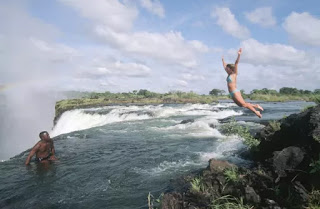LIVING STONE IRLAND, ZAMBEZI
One of the most thrilling experiences not only at the falls, but in Africa, is the hair-raising journey to Livingstone Island. Here you will bathe in Devil's Pool – nature’s ultimate infinity pool, set directly on the edge of the raging drama of Victoria Falls. You can leap into the pool and then poke your head over the edge to get an extraordinary view of the 100m drop.
Livingstone Island is in the middle of the Zambezi River, located at the top of the falls, and here you'll see a plaque marking the spot where David Livingstone first sighted the falls. The island is accessed via boat, and prices include either breakfast (ZMW333), lunch (ZMW615) or high tea (ZMW486). When the water is low, you’re able to access it via walking or swimming across, but a guide is compulsory. Note that access to the island is closed from around March to May when the water levels are too high.
If Zanzibar Town is the archipelago's heart, Stone Town is its soul. It's magical jumble of cobbled alleyways make it easy to spend days wandering around and getting lost - although you can't get lost for long because, sooner or later, you'll end up on either the seafront or Creek Rd.
Nevertheless, each twist and turn of the narrow streets brings something new - be it a school full of children chanting verses from the Quran, a beautiful old mansion with overhanging verandas, or a coffee vendor with his long-spouted pot fastened over coals.
Along the way, watch the island's rich cultural melange come to life: Arabic-style houses with their recessed inner courtyards rub shoulders with Indian-influenced buildings boasting ornate balconies and latticework, and bustling oriental bazaars alternate with street-side vending stalls.
SERENGETI TANZANIA
The world-renowned Serengeti National Park needs little in the way of introduction; its tawny, wildlife-stuffed savannahs are familiar to everyone who owns a TV set and the scene for umpteen documentaries and films.
Reliable rains and plentiful vegetation underpin this extraordinary ecosystem and the millions of herbivores it supports. Wildebeest, zebra, impala, elephant, Masai giraffe and several species of gazelle all call the Mara home. This vast concentration of game accounts for high predator numbers including cheetah, leopard and the highest lion densities in the world.
Serengeti National park (or Mara as locals affectionately refer to it) is the northern extension of Tanzania’s equally famous Serengeti Plains and is jointly managed by . The whole ecosystem is greatly extended by the numerous privately and community owned conservancies and group ranches that surround the reserve.
For nearly 4000 years, the extraordinary shape, impeccable geometry and sheer bulk of the Giza Pyramids have invited the obvious question: ‘How were we built, and why?’
Centuries of research have given us parts of the answer. We know they were massive tombs constructed on the orders of the pharaohs by teams of workers tens-of-thousands strong. This is supported by the discovery of a pyramid-builders’ settlement, complete with areas for large-scale food production and medical facilities.
Ongoing excavations on the Giza Plateau have provided more evidence that the workers were not the slaves of Hollywood tradition, but an organised workforce of Egyptian farmers. During the flood season, when the Nile covered their fields, the same farmers could have been redeployed by the highly structured bureaucracy to work on the pharaoh’s tomb. In this way, the Pyramids can almost be seen as an ancient job-creation scheme. And the flood waters made it easier to transport building stone to the site.
But despite the evidence, some still won’t accept that the ancient Egyptians were capable of such achievements. So-called pyramidologists point to the carving and placement of the stones, precise to the millimetre, and argue the numerological significance of the structures’ dimensions as evidence that the Pyramids were constructed by angels or aliens. It’s easy to laugh at these out-there ideas, but when you see the monuments up close, especially inside, you’ll better understand why so many people believe such awesome structures must have unearthly origins.








ConversionConversion EmoticonEmoticon